#spanish bullfighting music
Text
youtube
Pasodoble torero "La Entrada", de Quintín Esquembre.
#spain#españa#spanish#español#espana#espanol#bullfighting#bullfighting music#spanish bullfighting music#Youtube
3 notes
·
View notes
Text
youtube
Banda del Maestro Tejera: "Plaza de La Maestranza" (nombre de la plaza de toros de Sevilla), popular pasodoble en el paseíllo inicial de las corridas de toros. En la imagen, el torero Morante de la Puebla.
#spain#españa#spanish#español#espana#espanol#bullfighter#bullfightin#bullfighting music#sevilla#Youtube
2 notes
·
View notes
Video
youtube
Banda del Maestro Tejera: “Plaza de La Maestranza”. Pasodoble taurino muy frecuente el paseíllo de las corridas sevillanas.
#youtube#bullfighting#seville#sevilla#spain#españa#spanish#español#espana#espanol#bullfighting music#pasodoble taurino
2 notes
·
View notes
Text
Las Vulpess: the scandal
Just 40 years ago, four girls from the Bilbo neighborhood of Irala, between 17 and 21, starred in the first media scandal related to freedom of expression in Spain. Las Vulpess had not yet recorded a single single when the music critic Carlos Tena decided to make a music video with them on his new program on TVE, Caja de ritmos.
The sisters Loles and Lupe Vázquez (guitar and drums, respectively), were responsible for adapting the lyrics of I Wanna Be Your Dog - by Iggy Pop & The Stooges - in their own way, which Mamen Rodrigo would sing while Begoña Astigarraga played the bass. The song's title?: I like to be a whore.
youtube
Nothing happened at that time, since it was a program with a very small audience. The scandal erupted ten days later, when newspaper ABC published the lyrics of the song and vigorously protested its broadcast in children's programming hours, arguing that the song "degrades Spanish society, revolts the father of a family, unworthy the responsible citizen, breaks the intimacy of the home, violates what is established in the Constitution and goes beyond the limits of what is tolerable".
The media of that time asked for heads to roll: Caja de ritmos was not broadcast again, the presenter submitted his resignation and, the following Saturday, what the children's audience could see at that time was… a bullfight.
The snowball continued to grow until it reached the courts. The State Attorney General's Office filed a criminal complaint against the director of the program "for offense to modesty and good customs" and Loles Vázquez as the author of the lyrics and Mamen Rodrigo as vocal interpreter for public derision. Three, five years in prison and ten years of disqualification were requested for them. In 1986, the case was dismissed.

Thanks to growing up in very politically committed families, Loles – whose parents had fought against Franco in hiding, from unionism and women's associations – also had that support.
"My family helped us, my parents and brothers understood and supported us, we all went together, and it was quite important to feel so supported," the guitarist confesses. "We did not fear for our future, but of course it did worry us, because handling a scandal at the age we were was not easy, on the contrary, it was very difficult. A lot of stress, the phone did not stop ringing, everybody wanted to exploit the whole scandal: first musically and then the media, the political parties… It was pretty fucked up, speaking clearly".
Las Vulpess were the first all-female punk-rock quartet in Spain. I would venture to say that, even, rock in general. "If in the US or England it was already difficult for women to be in a rock group, well imagine in the Basque Country at that time. Even the boys had a hard time getting their instruments or a place, nobody had money, we were in a super harsh crisis. Rock and roll was very sexist, women's work was basically escort, groupie. Punk revolutionized everything, and one of the things that changed was the role of women. We too could be in a stage", concedes Loles Vázquez.
Now we are more accustomed, not only in punk but in more formal commercial pop, to hearing the word "bitch" or "whore" reversing its connotations of insult as a symbol of pride and self-affirmation. And, although it is impossible to collect data that proves anything, if they were not the first in the world, Las Vulpess sure were pioneers in this. Before rappers like Queen Latifah or MC Lyte began to use "bitch" in the same way in the US at the end of the 80s, no other precedents have been revealed. "I first played with Latin, hence the Vulpes thing," [Vulpes means fox in Latin, fox in Spanish has the same meaning that bitch in English] explains the author of the adaptation, which she wrote at the age of 15.
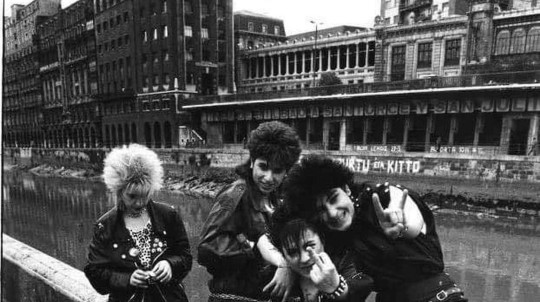
"It was what I received then. I wore leopard miniskirts made from car upholstery, we tore our stockings at the feet, because there weren't those things like leggings today… So with those looks, the stiletto shoes, the nets, the eyes painted with the eyeliner, when the guys passed by me they yelled at me: Whore! That was what they called me the most. And, well, I liked it. I liked being who I was. Being different was a source of pride. Those guys who defended marriage and those who were junkies and considered themselves cool, all told me the same. All those people calling me a bitch made me think, to that age, that being a whore was cool."
But what happened to Las Vulpess? Their label, Dos Rombos, hurried them to record the single that quickly sold out a circulation of 7,000 copies and, shortly after, sold 5,000 more, but the girls said they saw hardly any money from it.
Although the worst came with the concerts. On May 18, 1983, barely a month after the controversy, they performed at the temple of the Movida in Madrid, the Rock-Ola. But they ran into the peculiar reception of the security personnel in the room, who gave them a beating in the dressing room for singing a song critical of the Police. According to what Las Vulpess recounted, when they went to the nearest police station to report what had happened, they found that the agents who attended them were the same ones who had attacked them. They were policemen who had infiltrated the concert. It was not the only time, as confirmed by the guitarist.
"Yes, they used to beat us, yes. We were included in concerts with groups that had nothing to do with us. Then the press also released many lies and there were people who thought we would go out naked or in our panties. People weren't going to see a punk rock concert, they were going to cause a scandal. Buses full of fascists also came to boycott us, and we had to get out on our feet many times".

"In the end, everybody wanted to take advantage -adds Loles-, we were fresh meat, and both the politicians and the promoters took advantage, (…) they took all the money and we could not return home. All that burned us out a lot, it annoyed us quite a bit, and clearly, that caused us to break up, although it must also be emphasized that there were already musical differences between us".
That summer at the Bilbo festivities Las Vulpess said "enough" and disbanded a fortnight before entering to record what should have been their first album.
Source
#euskadi#euskal herria#basque country#pais vasco#pays basque#las vulpess#basque people#euskal musika#punk#history#awesome women#spain#Youtube
86 notes
·
View notes
Text
Today's translation #626
Go Yuri!!! Go official fanbook, Tominaga Keisuke comments
Rapsodie espagnole
"The orthodox approach" [as in 'a classic men's figure skating program'], "magnificence" and "a powerful player" were the key words that we've received for this one. From the mix of royal style, passion and sex appeal, my mind produced an image of Spanish bullfighter. Based on this concept, Matsushiba-kun further developed the motif of the music and composed a powerful and stern orchestra piece with ethnic and elegant feel. The oboe part performed by Ensemble FOVE's Araki Kanami also have a lot of sexiness in it, and I think it matches Chris' program very well.
(+ Matsushiba Taku's comment) There are a few musical composition with the same name, by Liszt and by Ravel, for example - 'Rapsodie espagnole/Spanish Rapsody'. There was a time in the past, when Spanish style was very popular in classical music. I think that this music inherited a lot from that tradition. It's one category in the 'classical music meets exoticism' genre.
9 notes
·
View notes
Note
On the topic of trolls and real world races. I thought that Tavros was supposed to be Spanish.
I can see where you are coming from. Part of his screen name is adios, meaning goodbye in Spanish. And Toreador is a bullfighter. Not only that, his music theme has that feel too. Guitars being one of main instruments used to signal Tavros.
7 notes
·
View notes
Text
( ge.eta-related fun facts! )
// okay, here comes a ge.eta-related infodump-

as someone from spain, i need to say that ge.eta isn't really south asian/indian, but ca.lé (iberian, and especially spanish, ro.mani). i am aware that ro.mani people in general have been suggested to have originated in india though, which explains this widespread belief in the fandom i guess?, and if true would mean it isn't 100% incorrect (i thought it was outright confirmed but apparently it's still debated? apologies if i'm wrong on that front), but there's plenty of proof in her design, team set-up and even her battle theme to demonstrate that she's cal.é/rom.ani
(as a disclaimer, while i am not ca.lé myself, i am from spain and live in an area widely populated by ca.lé people, so i am just giving my two cents, as ca.lé people have influenced and created very representative parts of our culture as a whole, and should be talked about more often!):
her battle theme features instruments and cadences that are common in flamenco (spanish guitar) and pasodoble (trumpets), with flamenco being a spanish music genre which has been agreed upon was created by the andalusian ca.lé, and pasodoble being also a music genre that's prominently featured in bullfighting, whose origins aren't all very clear, but is agreed to have both spanish and french origins (which ties into things that are discussed below). while i'm not super familiar with the french side of things, chunks of her theme are also extremely reminiscent of music featured in the kalos games.
design wise, she follows the very common artistic representation, from her beautifully thick eyebrows to the golden accents in her clothes and bits in her parted pitch black hair and even in her eyes - golden accessories, especially worn around the neck, are a symbol of high status and wealth in ca.lé society, tying nicely into her champion position.
most ca.lé people live in spain, with smaller populations in portugal and southern france, and this is mirrored in her Pokémon team, with Pokémon first introduced in paldea (espathra, glimmora, kingambit, veluza) and kalos (gogoat, avalugg + chesnaught in the DLC). espathra being in her team and being based on an ostrich and on cleopatra could also be a nod to the (very erroneous, mind you) belief that ro.mani people originated from egypt.
her english and spanish names, gee.ta and ságita, both reference the scientific name of the threeleaf arrowhead (Sa(gitta)ria trifolia), as well as sound very similar to the spanish exonym used by payos (non-calé) to refer to the ro.mani, gitan.o. sagitta comes from latin (meaning 'arrow'), which imo lends itself into the zodiac constellation Sagittarius, referencing ties rom.ani/ca.lé people have to fortune-telling, seen as an exclusively female profession in their culture.
there's probably other things that i'm missing or have forgotten, but those were the ones that stood out to me the most- from the moment i saw her in the first trailers, she struck me as super familiar in vibes, and after a bit of both digging and consideration, i feel super happy to see such nice ca.lé representation in a pokémon game based on the iberian peninsula, my homeland!
while doing research for this, i learned that the exonym used to refer to romani people in english and the one in spanish come from the same erroneous belief that they came from egypt. in english, said exonym can be and is often viewed by english-speaking ro.mani people as offensive, but the spanish equivalent isn't really seen that way where i live, which is why i use the spanish one but not the english one! just wanted to clarify-
#( ooc );#( long post );#( just fun observations and clarifications imo! she's my fav champion of all time#and one of the biggest reasons is because of all the cultural inspiration i see in her!! it's super mind-blowing if you look into it!! )#( PERSONALS DON'T REBLOG )
9 notes
·
View notes
Text
Tex vs Tank is my favorite track from s10, and it’s all because of the Spanish influenced trumpet. I was listening to it today when I realized that it’s there because that scene is a bull fight. Someone up against a much larger animal and defying the odds by defeating it. I wanted to confirm that by listening to some bull fighting music and i was so right (The Bullfighters song by Luis Arcaraz). my god Jeff Williams i love you
#rvb#red vs blue#I LOVE THE RVB SOUNDTRACK SM#AAAAA OMG MUSIC AS STORYTELLING#i rewatched s9 and s10 just for this scene#i didn’t have to but my hyperfixation on rvb is my life rn#Spotify
11 notes
·
View notes
Text
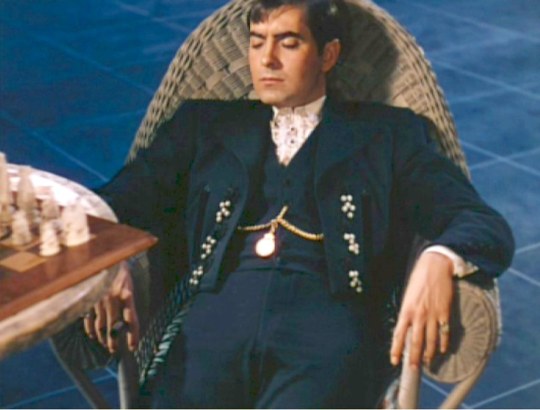
Tyrone Power in Blood and Sand (Rouben Mamoulian, 1941)
Cast: Tyrone Power, Linda Darnell, Rita Hayworth, Alla Nazimova, Anthony Quinn, J. Carrol Naish, Lynn Bari, John Carradine, Laird Cregar. Screenplay: Jo Swerling, based on a novel by Vicente Blasco Ibáñez. Cinematography: Ernest Palmer, Ray Rennehan. Art direction: Richard Day, Joseph C. Wright. Film editing: Robert Bischoff. Music: Arnold Newman.
Vicente Blasco Ibáñez's novels aren't read much anymore, but they were a fertile source for screenwriters in the silent era, providing two vehicles for Rudolph Valentino, Blood and Sand (Fred Niblo, 1922) and The Four Horsemen of the Apocalypse (Rex Ingram, 1921), and two for Greta Garbo, Torrent (Monta Bell, 1926) and The Temptress (Niblo, 1926). It was probably the Valentino connection that led producer and studio head Darryl F. Zanuck to revive Blasco's old warhorse Blood and Sand as a vehicle for Twentieth Century Fox's biggest male star, Tyrone Power. He plays Juan Gallardo, the son of a bullfighter who was killed in the ring. The movie follows Juan's rise and fall, as he becomes the greatest matador in Spain, but finds love and glory too much to handle. It's genuine cornball stuff, with the usual characters: his sweet and devoted wife, Carmen (Linda Darnell); the temptress Doña Sol (Rita Hayworth), who steals him away from Carmen; and the devoted mother (Alla Nazimova) who prays that he'll be gored in the ring just bad enough to get him out of the game that killed his father. Darnell's is a thankless role, and it's not made any better by the decision to include a scene in which Carmen prays to the Virgin and we hear both her prayer and the Virgin's response to it in voiceover. Hayworth is sensational, however, never better than in a scene in which she dances with Manolo (Anthony Quinn), a friend of Juan's who has set out on his own to become a rival bullfighter. The Technicolor cinematography won an Oscar, and some of the credit goes to director Rouben Mamoulian, who wanted to evoke the palette of Spanish painters like Goya and Velázquez. Mamoulian has to be faulted, however, for the thudding obviousness of the death scene of Nacional (John Carradine), one of Juan's friends, who expires with his arms stretched out in a pose that recalls the crucifixes often seen in the film. The bullfight scenes, shot in Mexico, were supervised by Budd Boetticher, who had done some bullfighting there. They are, fortunately for those of us who find the sport repellent, kept to a minimum -- there's more sand than blood to be seen.
2 notes
·
View notes
Photo





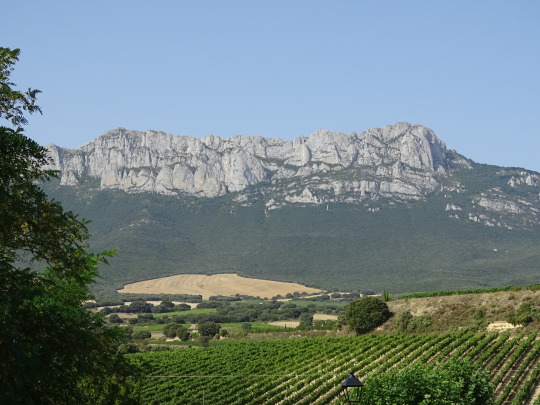


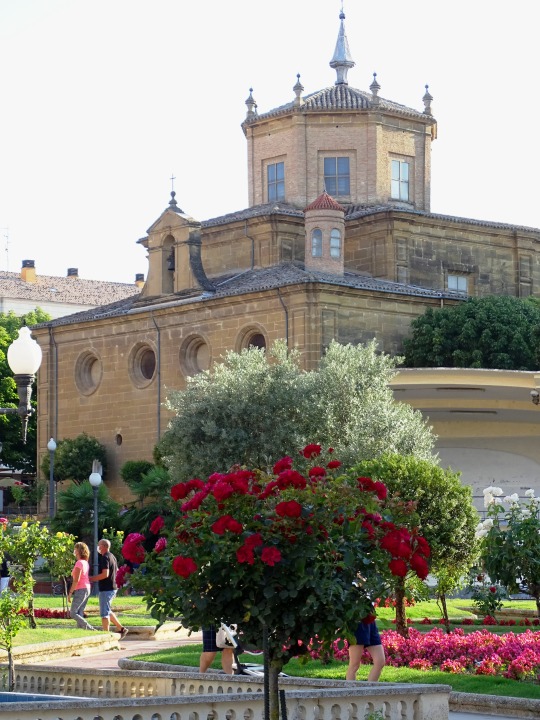
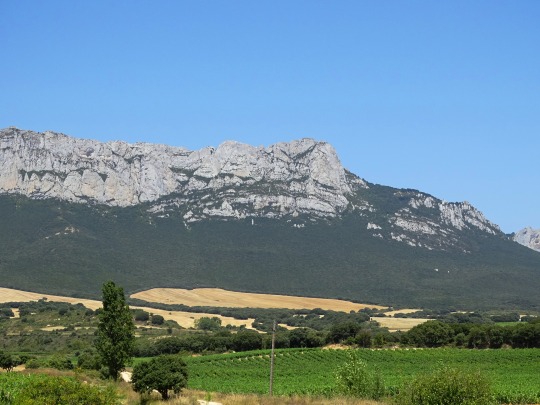
Day of La Rioja
Day of La Rioja is a public holiday in La Rioja, Spain, and is celebrated on June 9 every year. It marks the anniversary of when the autonomous community of La Rioja’s statute was approved in 1982. This beautiful picturesque region is known for its lip-smacking red wine and boasts of over 500 wineries. We firmly believe that there is no such thing as too many wineries but 500 sounds like a good number. The day is celebrated with full vigor in the region by organizing various events including exhibitions of works produced by local artists, traditional and modern music concerts, sports events, and, of course, cooking up some great dishes and washing them down with the world-famous La Rioja wine.
History of Day of La Rioja
The history of La Rioja is marked by territorial disputes and invasions. The territory of La Rioja was inhabited by the tribes of the Berones, Autrigones, and the Vascones during Roman times, while in Medieval times, it was often a disputed territory. After a Muslim Invasion in 711, La Rioja fell into the Muslim domains of Al Andalus. This was followed by more disputes and invasions, which were then followed by — you guessed it — even more disputes and invasions.
The territory was divided between the provinces of Burgos and Soria as recently as the 19th century. Even France had its say. Napoleonic forces took over the region during the Peninsular War, keeping it with the French till 1814.
Historically, La Rioja formed part of different provinces in the area but became its own province in 1833. It was called the Province of Logroño. The province was renamed La Rioja in 1980, although Logroño is still the capital city.
Today, this community forms the least populated region of Spain with over 300,000 inhabitants. It also has its own flag with the colors red, white, green, and yellow. The residents of this region take a lot of pride in their land. Other events like the Vendimia Riojana are also celebrated in the region. It is held during the third week of September in Logroño to celebrate the grape harvest with festivities, including a parade of carts and bullfights.
Day of La Rioja timeline
1550 B.C. The Iberian Peninsula
The Bronze Age begins and the El Argar civilization starts to form.
19 B.C. The Romans Take Over
Spain falls under the Roman Empire.
1479 The New Kingdom is Formed
The Kingdom of Spain is formed when Ferdinand and Isabella become king and queen.
1931 Spain As We Know It
Spain becomes a republic.
Day of La Rioja Activities
Visit La Rioja
Bring Spain home
Treat your friends
Take a trip to La Rioja to see the festivities for yourself. Bask in the Day of La Riojaculture, food, and wine that makes this region so unique.
If you cannot visit La Rioja, then bring Spain to your home. Cook up some delicacies from La Rioja like Patatas a la Riojana, beef, or pork cheeks in Rioja red wine sauce and white asparagus.
Call your family and friends over and treat them to some delicious food made in La Rioja style. Open up a bottle of wine while you are at it.
5 Facts About Spain That Will Blow Your Mind
Spanish is widely spoken
The world’s first global empire
The world’s oldest restaurant
Spain has a tooth mouse
More bars than anywhere in Europe
Spanish is the world’s second-most spoken native language.
The Spanish traveled across the world and left their mark on the Americas and also controlled the Philippines for over 300 years.
Madrid has the oldest restaurant in the world, El Restaurante Botin, which was opened in 1725.
Spain has a unique version of the popular mythical tooth mouse called ‘Ratoncito Perez.’
Spain has the highest number of bars compared to other countries in Europe.
Why We Love Day of La Rioja
The Spaniards know how to have fun
They make some great art
It is beautiful
We love any reason to have a celebration! La Tomatina and the Haro wine festival are just some of the popular festivals held in Spain.
Some of the world’s most famous painters including Pablo Picasso, Salvador Dali, Goya, El Greco, and Velázquez all came from Spain. There is nothing better than appreciating a good work of art.
It does not matter if you are into food, wine, beaches, history, art, or architecture — Spain has it all. Spain is such a popular country that in 2018 the country had more visitors than the number of people who live there!
Source
#San Vicente de la Sonsierra#Haro#puente medieval#medieval bridge#Spain#Bodegas Roda#Ebro River#Church of Santo Tomás#La Rioja#vacation#travel#Basilica of la Vega by Bernardo de Munilla and Juan de Villanueva#Day of La Rioja#DayofLaRioja#9 June#original photography#summer 2021#landscape#cityscape#countryside#vineyard#architecture#mountains#España#Northern Spain#Southern Europe
2 notes
·
View notes
Text
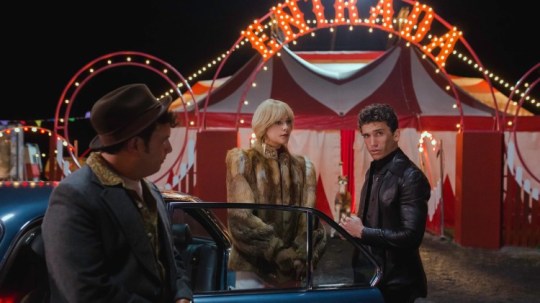
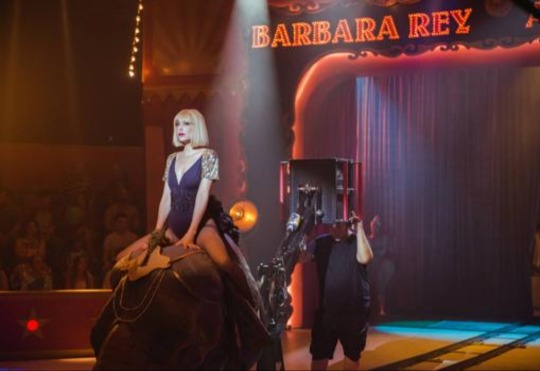








Cristo y Rey (2022)
@asongofstarkandtargaryen there's a new upcoming series with Belén Cuesta and Jaime Lorente, and they play the leading couple, Bárbara Rey and Ángel Cristo.
Synopsis
Madrid, 1979. Ángel Cristo is the most famous circus tamer of the county. Bárbara Rey, actress and muse of uncovering, the most desired woman in Spain. From the time they meet until they announce their marriage, only a few weeks pass. It is the wedding of the year and the news covers the covers of all the magazines. The Circus of Bárbara Rey and Ángel Cristo becomes the fashion show; a million dollar business money, fame, luxury…
Nine years of relationship in which Spain witnessed the happiness of the couple: the birth of Angelito and Sofía, the purchase of sports cars, jewelry, an ostentatious villa in La Moraleja… Far from the flashes, however, there is an escalation of drug addiction, gambling, infidelity and abuse...
And, in the background, the shadow of Barbara's relationship with Juan Carlos I (she was the king's lover between 1976 and 1994)
Cast
Belén Cuesta as Bárbara Rey (Totana, Murcia, 2th February 1950-), artistic name of María García García, daughter of Andrés García Valenzuela and Salvadora García Molina. She firstly started her career as a dancer, but then she became an actress, vedette & tv presenter on theatres, cinema and tv shows, and during her marriage with Ángel Cristo she became an elephant tamer.
Jaime Lorente as Ángel Cristo (Huelva, Andalucía, 17th October 1944- Alcorcón, Madrid, 4th May 2010), artistic name of Ángel Papadopoulos Dordid, son of Christoforo Papadopoulos Stanovich a Greek of Romani descent trapeze artist and the Spanish contortionist Margarita Dordid. They were a family of famous circus performers. Christoforo's brother, Miro who owned the Circus Florida, married also a woman from Málaga called Canela Remedios Vaquero and has 8 children together, some of them became very famous, like their eldest daughter, María del Pino Papadopoulos Vázquez known as "Miss Mara" who became an internationally famous trapeze artist and some of her brothers formed a group of phonanbulists called "Tonitos".
Ángel he received the Gold Medal of the International Circus Festival in 1982 and founded his own circus, the Russian Circus.
Adriana Torrebejano as Chelo García Cortés, a queer journalist and tv presenter who had a brief love affair with Bárbara Rey in the 80's. Chelo was in a relationship with the tv journalist José Manuel Parada Rodríguez during those years but it's said that she came out of the closet because of Bárbara and then she ended up broking up with her partner.
Artur Busquets as Francisco Javier García-Ontiveros "Payasito" (Little Clown), Ángel's best friend and a member of the Russian Circus.
Chema Adeva as Christoforo "Cristo" Papadopoulos Stanovich
Belén Ponce de León as Margarita Dordid "the little Carolina"
Vicente Vergará as Andrés García Valenzuela
Diana Peñalver as Salvadora García Molina
José Milan as Blasco
Cristóbal Suárez as Juan Carlos I
Salomé Jiménez as Queen Sofía
Secun de la Rosa as Richardi
David Lorente as Paco Ostos
Ana Carrasco as Hortensia
Mirela Balic as Cata
Antonio Buil as Mancuso
Elvira Cuadrupani as Patri Veracruz
Jesús Castro as bullfighter Francisco Rivera "Paquirri"
Julián Teurlais as Doctor 1
Data sheet
Creator/Showrunner: Daniel Écija
Executive production: Montse García and Daniel Écija
Script coordinator: Andrés Martín Soto and Patricia Trueba
Screenplay: Daniel Écija, Andrés Martín Soto, Patricia Trueba, César Mendizábal, Iñaki San Román, Ángel Gasco-Coloma
Direction: David Molina and Manu Gómez
Production Direction: Salvador Gómez
Casting direction: Ana Sainz-Trápaga and Patricia Álvarez de Miranda
Director of Photography: Tommie Ferreras
AEC, 2nd unit: Ismael Issa
Art Direction: Koldo Valles
Costume Design: Loles Garcia
Makeup and costume design: Romana González 'Pato' and Antonio Panizza
Music: Daniel Sánchez De La Hera
Sound: Néstor Luz
Editor: Fernando Márquez
Special Effects (VFX): Jordi San Agustín and Álvaro Vicario
#series#period dramas#belén cuesta#jaime lorente#bárbara rey#ángel cristo#biopics#cristo y rey 2022#upcoming series#secun de la rosa#artur busquets#adriana torrebajano#david lorente#elvira cuadrupani#chema adeva#salomé jiménez#ana carrasco#josé milan#antonio buil#mirela balic#belén ponce de león#vicente vergará#diana peñalver#jesús castro#julián teurlais
5 notes
·
View notes
Text
youtube
Provided to YouTube by IDOL: Pasodoble Taurino titled "Calle Sierpes" · Musique du Rgt. Inf. "Inmemorial del Rey" n° 1, Armée Espagnole. Pasodobles de oro. ℗ Agorila. Released on: 2004-01-01. Composer: Abel Moreno. Auto-generated by YouTube.
#spain#españa#spanish#español#espana#espanol#bullfighting#tauromaquia#toreo#spanish bullfighting music#pasodoble taurino#Youtube
2 notes
·
View notes
Text
youtube
Quintín Esquembre Díaz: "La Entrada", pasodoble taurino
#españa#spain#spanish#español#espana#espanol#bullfighting#bullfighting music#pasodoble taurino#Youtube
2 notes
·
View notes
Text
Abhi in Paris
Reflections on My Time Abroad!
This is it - it's exam week at ENSEA. My time abroad has come to an end. My semester in Paris was an adventure filled with unforgettable moments, invaluable lessons, and experiences that I'll treasure forever. Studying at ENSEA in Cergy gave me a unique opportunity to dive into French culture, explore Europe, and gain new perspectives that have deeply impacted my personal growth. I've been so fortunate to blog this journey every week, and I hope these accounts help inform future study abroad applicants of the amazing experiences that lay ahead :)
The Allure of Paris
Paris stole my heart from day one. Iconic landmarks like the Eiffel Tower, Louvre Museum, and Notre-Dame Cathedral were the scenes I passed to class on a daily basis. I enjoyed evenings along the Seine, running in Les Invalides, eating & shopping in Le Marais, and so much more. I feel at home here now, and it's definitely going to be an adjustment to be back in the U.S. I'll always remember this city for the challenges it posed and the amazing opportunities it brought, and I just hope I can visit again soon.



ENSEA
Studying at ENSEA was both challenging & rewarding. The academic intensity pushed me to expand my electrical engineering knowledge while working with students from diverse backgrounds. The experience of studying in a different educational system taught me adaptability and resilience. It's the small things like a completely different scheduling process and interactions with French students that help you grow into a more confident and inclusive person that can handle changing circumstances. I'm gonna miss the school, the professors, and the students.
Adventures Beyond Paris
My travels extended beyond Paris, allowing me to experience Europe's richness. Each country I visited offered unique experiences and lessons:
Italy: History and Cuisine
In Italy, I was awed by Rome's ancient ruins, Florence's Renaissance art, and Venice's romantic canals. The country's history and artistic heritage were incredible. I ate delicious Italian food, from authentic pasta to mouthwatering gelato. Italy taught me to savor life's pleasures and appreciate the beauty of the past. And the best part, I walk a way from Italy with a much stronger knowledge of Italian cooking that I fully plan to put to use.


Spain: Culture and Tradition
Spain's vibrant culture and traditions left a lasting impression. From Madrid's bustling streets to Barcelona's architectural wonders, every city had its charm. Experiencing flamenco dancing, enjoying tapas, and witnessing a traditional bullfight were highlights of my Spanish adventure. Spain reminded me to live in the moment and celebrate diversity.
Germany: History and Modernity
Germany's blend of historical significance and modern innovation fascinated me. In Berlin, I visited the Berlin Wall remnants and learned about the city's history. German engineering's efficiency was evident in Munich and Frankfurt. Experiencing Germany's culture, from festive beer gardens to rich musical heritage, deepened my understanding of the country's resilience and progress. Germany reinforced the importance of learning from history to build a better future.


Personal Growth and Lessons Learned
Throughout my time abroad, I experienced tremendous personal growth. Living in a foreign country challenged me to step out of my comfort zone and adapt to new environments. I became more self-reliant, confident, and resourceful. Navigating language barriers and cultural differences taught me empathy and effective communication.
One of the most significant lessons was embracing uncertainty and seizing opportunities. Spontaneous trips, unplanned adventures, and local interactions often led to the most memorable experiences. I discovered that the best moments often come from unexpected encounters and uncharted paths.
My time in Paris also deepened my appreciation for diversity and global interconnectedness. Meeting people from different cultures, hearing their stories, and sharing mine broadened my horizons and fostered unity. I realized that despite our differences, we all share common aspirations and dreams.
Gratitude and Moving Forward
Reflecting on my semester abroad, I'm filled with gratitude for the incredible journey and lessons learned. The experiences in Paris and beyond have shaped me into a more open-minded, resilient, and culturally aware person. I'm grateful for the friendships, places explored, and personal growth achieved.
Moving forward, I carry the spirit of adventure, appreciation for diverse cultures, and lessons of adaptability and resilience. My time abroad inspired me to continue exploring, seeking new experiences, and embracing the unknown. I'm excited to apply these skills and perspectives to future endeavors, both personally and professionally.
In conclusion, my semester in Paris was a transformative journey that enriched my life in countless ways. The memories, lessons, and people I met will forever hold a special place in my heart. As I embark on new adventures, I carry the spirit of Paris and the invaluable experiences that have shaped who I am today.
A plus (for the last time!!),
Abhi Athreya
University of Michigan, Aerospace Engineering 2025
ENSEA in Cergy, France
0 notes
Text
This Week’s Horrible-Scopes
It’s time for this week’s Horrible-Scopes! So for those of you that know your Astrological Signs, cool! If not, just pick one, roll a D12, or just make it up as you go along. It really doesn’t matter. Better yet! Check out “Heart of the Game, Fredonia” and see if they can sell you those D12’s with the symbols on them. Tell them “Shujin Tribble” sentcha. And “Hail, Hail, Fredonia!” Home of the Blue Devil!
Someone, and we’re not naming names here, someone is really trying to challenge me with suggestions for the ‘Scopes; trying to stump me with topics. WELL! Just to prove that I refuse to be stumpified let’s launch into this week’s suggested topic: HATS! So hold on to yours because it’s time to duel!
Aries
Hey, Ladies! Let’s give you something classy as all hell. You might not know it by the name, “Cloche hat”, but you’ll know it on sight. It’s a bell-shaped woman's hat that was popular during the Roaring Twenties. So This Week… Head to a 2nd-hand shop and try on a Flapper Dress, but with two warnings. First, it’s heavier than you think it’ll be. And Second… it’s gunna cost more than you think it will.
Taurus
We’re taking you to a hard felt hat created in 1850 by Lock's of St James's, the hatters to Thomas Coke, 2nd Earl of Leicester, for his servants. So, yeah! You’re getting a hat fit for “The Help”. Commonly known as a “Derby” in the United States, your hat is also the name of a legendary restaurant. So This Week… Re-watch the old “Little Rascals” films and look for the kid with the bowler hat. That would be Stymie Beard. That hat? It was a gift from comedian Stan Laurel - of “Laurel & Hardy” fame! So you wear yours with PRIDE!
Gemini
JUST for you, we’re taking you to school. Specifically to Italian class. “Da Cappo” in Italian means “The Hat”, but it’s better than that. It’s a Musical Term, meaning once you get to this point, go back and start at the beginning all over again. So for This Week… You’re being challenged to pick up that first instrument you learned in third grade and try to play something again. Unless it was a recorder, in which case you’re off the hook.
Cancer Moon-Child
You’re getting a pretty famous hat, though you might not know it by name. Known as the "Smokey Bear" hat, it’s a broad-brimmed felt or straw hat with a high crown, pinched symmetrically at its four corners - what’s known as the "Montana Crease". Your hat is officially known as the “Campaign Hat”. So This Week… Remember; “Smokey the Bear” was named for "Smokey" Joe Martin, a New York City Fire Department hero who suffered burns and blindness during a bold 1922 rescue. So when you put on your hat, give it its proper reverence.
Leo
Let’s take you all the way back to the Bronze Age and give you a Beret! Sure, in modern times you could look like a military person, but really you’ve got one of the oldest designs of lid-wear. So This Week… Don’t try to wear it as a cold-weather hat. It’s just going to blow right off your head. Unless you buckle it tighter. REALLY tight!
Virgo
You know, all these hats that everyone knows by sight but almost never by name. Virgo, do you know what a “Bobby” is? It’s what they call a constable in the UK. So you’re getting the “Custodian helmet”. Yes, it’s a helmet, but that’s still a hat. So This Week… Do NOT learn how to speak with a British Accent from ‘Mary Poppins’!
Libra
Oh, we’re gunna screw you up hard with this one. Surprisingly enough it could be found in some of the Southernmost Islands of Japan. It's called the “Montera” - a crocheted hat worn by bullfighters. Yeah! Bullfighting was a THING in Super-South Japan thanks to Spanish Settlers. Bet you didn’t know that. So This Week… Watch Bugs Bunny be a bullfighter and remember you can’t do that! He’s a toon, you're not. Stick to Mechanical Bull Riding.
Scorpio
You’re getting an Australian favorite, believe it or not. It’s a bush hat with a wide brim known as the “Akubra”. It’s a distinctive part of Australian culture, especially in rural areas these days, and if you pair it with an oiled canvas riding jacket, you WILL be the sexiest person in that county. So This Week… See if the Driza-Bone company can ship a Rider Heritage Coat to your country yet.
Sagittarius
Are you going to be in a production of The Pirates of Penzance? No? Then you’re gunna look weird wearing a Pith Helmet. But we’re pretty sure you know how to find a rhyme for the term, “Hypotenuse”. So This Week… Learn the lyrics from “Major General”. You’re just dorky enough to remember it later.
Capricorn
It don’t get much more “Olde Timey” than this! You’re going to be wearing A seamen’s hat. No, it’s not what you think. Your hat, called the “Boater”, is a flat-brimmed, flat-topped, straw hat, formerly worn by public school students in the UK as part of their summer uniform. So This Week… since you won’t be going to a regatta or formal garden party this week, find a 1920’s schoolboy uniform to wear with it… Get a Gibson SG guitar and play “Thunderstruck”!
Aquarius
We’re gunna make a really strong suggestion: ONLY wear yours when you go in snow events. You’re getting a Balaclava. We don’t need to describe what it looks like other than to say, “If You Want To Rob A Bank, THIS Is The Hat You Want To Wear.” So This Week… Remember, you are NOT allowed to use money you’ve stolen to post bond for yourself. So just hit the ski slopes instead.
Pisces
If we say “Grandma”, or “Brrr!”, or “Eh?” what do you think of? That’s right - a stretched out sock, pulled over your head, known in Canada as.. The “Toque”. The worst part of it all is that Americans can’t seem to either pronounce it or spell it correctly - and maybe that’s for the best. So This Week… Learn to sing the PBR song from “Strange Brew!”
And THOSE are your Horrible-Scopes for this week! Remember if you liked what you got, we’re obviously not working hard enough at these. BUT! If you want a better or nastier one for your own sign or someone else’s, all you need to do to bribe me is just Let Me Know - or check out the Ko-Fi page ( https://ko-fi.com/icarusthelunarguard )! These will be posted online at the end of each week via Tumblr, Twitter, Facebook, Discord, and BLUESKY.
0 notes
Text
Georges Bizet Carmen suite

National Opera Orchestra of Monte-Carlo Direction: Paul Paray Georges Bizet's Carmen Suite is a captivating orchestral adaptation of his famed opera, Carmen. Georges Bizet, a French composer of the Romantic era, composed Carmen as an opera in 1875. Its success propelled Bizet to fame, with Carmen becoming one of the most performed and beloved operas of all time. The Carmen Suite, created posthumously, is a collection of selected pieces from the opera, arranged in a symphonic form. The Carmen Suite comprises six movements, each distinct in character and showcasing Bizet's gift for crafting memorable melodies: a) Prelude: The suite opens with a captivating prelude that sets the stage for the unfolding drama, introducing the audience to the passionate world of Carmen. b) Aragonaise: This lively and rhythmic movement evokes the spirit of traditional Spanish music, with its vibrant melodies and energetic rhythms. c) Intermezzo: A lyrical and tender interlude, this movement provides a moment of respite amidst the intense drama, showcasing Bizet's ability to evoke emotion through music. d) Seguidilla: This spirited movement captures the essence of the seductive character Carmen, with its sultry rhythms and alluring melodies. e) Les Dragons d'Alcala: A lively and rhythmic dance, this movement takes the listener on a musical journey to the streets of Seville, showcasing Bizet's flair for capturing the essence of Spanish folk music. f) March of the Toreadors: The final movement, known for its triumphant brass fanfare, captures the grandeur and excitement of the bullfighting arena. The Carmen Suite has garnered immense popularity and has become a staple of the orchestral repertoire. Its captivating melodies and vibrant rhythms have been embraced by audiences worldwide. The suite's ability to transport listeners to the passionate world of Carmen, with its blend of Spanish flair and intense emotions, has made it a perennial favorite. Bizet's Carmen Suite exemplifies his mastery of orchestration and his ability to create memorable melodies that resonate with audiences across generations. Its enduring popularity is a testament to its timeless appeal and the lasting impact of Bizet's music. Georges Bizet's Carmen Suite stands as a testament to the enduring power and beauty of his opera, Carmen. Through its vibrant melodies, rhythmic flair, and emotional depth, the suite captures the essence of the original opera and transports listeners to the passionate world of Carmen. Its popularity and continued presence in the orchestral repertoire reaffirm its status as a beloved masterpiece of classical music, ensuring that the enchanting beauty of Bizet's Carmen will continue to captivate audiences for years to come.
https://rumble.com/v1xscyc-georges-bizet-carmen-suite.html?mref=17947j&mc=9fatg
#classicalmusic#GeorgesBizet#Carmensuite#opera#orchestralsuite#Spanishmusic#romanticera#famouscompositions#operaadaptations#popularmelodies
0 notes